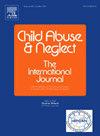Injury, child and family/contextual factors predict neurodevelopment outcomes after abusive head trauma
IF 3.4
2区 心理学
Q1 FAMILY STUDIES
引用次数: 0
Abstract
Background
There is a lack of consensus on how best to measure injury severity in abusive head trauma in order to predict long-term neurodevelopmental outcomes.
Objective
We hypothesized that a constellation of injury-related variables along with child and family variables would more accurately predict outcomes in children who have sustained an AHT than the Glasgow Coma Scale (GCS) alone.
Participants and setting
In 2012–2020, we enrolled 270 patients (median age 4.6 months) treated for AHT at a large tertiary care children's hospital who survived their injuries and came to a multi-disciplinary follow-up clinic.
Methods
Exploratory analyses examined bivariate relationships of injury severity and child and family variables with neurodevelopmental outcomes, as measured by the Bayley Scales of Infant and Toddler Development, using Pearson correlations, independent samples t-tests, and one-way ANOVAs. These exploratory analyses informed the selection of variables for stepwise multivariate regressions predicting neurodevelopmental outcomes.
Results
Stepwise regression revealed that a constellation of injury-related variables including cytotoxic edema, length of intensive care stay, neurosurgical intervention, seizures, intubation, eye injuries, and abnormal spine imaging explained significantly more variance in Bayley scores than GCS alone (14–22 %, all p-values < .01). The largest effect sizes were for measures of hospital course (length of intensive care stay, neurosurgical intervention, seizures, and intubation). Including child and family variables explained an additional 6–10 % of the variance (all p-values < .05).
Conclusions
A constellation of injury-related variables, especially those related to hospital course, was more predictive of neurodevelopment than solely GCS for children with AHT.
损伤、儿童和家庭/环境因素预测虐待性头部创伤后的神经发育结果
关于如何最好地测量虐待性头部创伤的损伤严重程度,以预测长期神经发育结果,目前还缺乏共识。目的:我们假设一系列损伤相关变量以及儿童和家庭变量比单独使用格拉斯哥昏迷量表(GCS)更准确地预测持续AHT儿童的预后。在2012-2020年,我们招募了270名在一家大型三级儿童医院接受AHT治疗的患者(中位年龄4.6个月),这些患者受伤后幸存并来到多学科随访诊所。方法探索性分析检查损伤严重程度、儿童和家庭变量与神经发育结局的双变量关系,采用Bayley婴幼儿发育量表,使用Pearson相关、独立样本t检验和单因素方差分析。这些探索性分析为逐步多元回归预测神经发育结果的变量选择提供了信息。结果逐步回归显示,损伤相关的一系列变量,包括细胞毒性水肿、重症监护时间、神经外科干预、癫痫发作、插管、眼部损伤和脊柱成像异常,解释了Bayley评分比单独GCS更大的差异(14 - 22%,所有p值<;. 01)。影响最大的是住院时间(重症监护时间、神经外科干预、癫痫发作和插管)。包括儿童和家庭变量解释了额外的6 - 10%的方差(所有p值<;. 05)。结论与损伤相关的一系列变量,特别是与住院病程相关的变量,比单纯的GCS更能预测AHT患儿的神经发育。
本文章由计算机程序翻译,如有差异,请以英文原文为准。
求助全文
约1分钟内获得全文
求助全文
来源期刊

Child Abuse & Neglect
Multiple-
CiteScore
7.40
自引率
10.40%
发文量
397
期刊介绍:
Official Publication of the International Society for Prevention of Child Abuse and Neglect. Child Abuse & Neglect The International Journal, provides an international, multidisciplinary forum on all aspects of child abuse and neglect, with special emphasis on prevention and treatment; the scope extends further to all those aspects of life which either favor or hinder child development. While contributions will primarily be from the fields of psychology, psychiatry, social work, medicine, nursing, law enforcement, legislature, education, and anthropology, the Journal encourages the concerned lay individual and child-oriented advocate organizations to contribute.
 求助内容:
求助内容: 应助结果提醒方式:
应助结果提醒方式:


